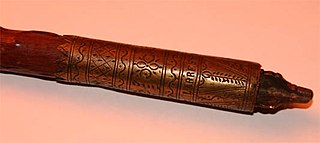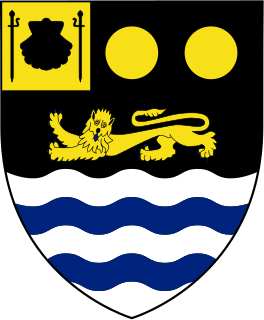 W
WA walking stick or walking cane is a device used primarily to aid walking, provide postural stability or support, or assist in maintaining a good posture. Some designs also serve as a fashion accessory, or are used for self-defense.
 W
WAaron's rod refers to any of the walking sticks carried by Moses's brother, Aaron, in the Torah. The Bible tells how, along with Moses's rod, Aaron's rod was endowed with miraculous power during the Plagues of Egypt that preceded the Exodus. There are two occasions where the Bible tells of the rod's power.
 W
WAn assistive cane is a walking stick used as a crutch or mobility aid. A cane can help redistribute weight from a lower leg that is weak or painful, improve stability by increasing the base of support, and provide tactile information about the ground to improve balance. In the US, ten percent of adults older than 65 years use a cane, and 4.6 percent use walkers.
 W
WThe caduceus is the staff carried by Hermes in Greek mythology and consequently by Hermes Trismegistus in Greco-Egyptian mythology. The same staff was also borne by heralds in general, for example by Iris, the messenger of Hera. It is a short staff entwined by two serpents, sometimes surmounted by wings. In Roman iconography, it was often depicted being carried in the left hand of Mercury, the messenger of the gods.
 W
WA cane gun is a walking cane with a hidden gun built into it. Cane guns are sometimes confused with so-called "poacher's guns".
 W
WThe makila is a traditional Basque walking stick, and is notable as both a practical tool and a cultural symbol of authority and strength.
 W
WThe pilgrim's staff is a walking stick used by pilgrims during their pilgrimages, like the Way of St. James to the shrine of Santiago de Compostela in Spain or the Via Francigena to Rome. In Rome, in the Middle Ages the pilgrims used to leave their stick in the church of San Giacomo Scossacavalli, whose first denomination was San Salvatore de Bordonia, where Bordone is the Italian word for Stick. After that, they bought a new stick by sellers named Vergari, whose shops were in today's Borgo Santo Spirito near the church of Santa Maria dei Vergari.
 W
WIn Greek mythology, the Rod of Asclepius, also known as the Staff of Aesculapius and as the asklepian, is a serpent-entwined rod wielded by the Greek god Asclepius, a deity associated with healing and medicine. Theories have been proposed about the Greek origin of the symbol and its implications. In modern times, it is the predominant symbol for medicine and health care although, because of a misunderstanding, the Caduceus is sometimes seen in this context.
 W
WA sceptre or scepter is a staff or wand held in the hand by a ruling monarch as an item of royal or imperial insignia. Figuratively, it means royal or imperial authority or sovereignty.
 W
WA Scout staff is a shoulder-high wooden pole or quarterstaff, traditionally carried by Boy Scouts as part of their accoutrements. Its main purpose was as a walking stick, but it had a number of other uses in emergency situations and can be used for Scout pioneering.
 W
WThe Staff of Moses is a staff mentioned in the Bible and Quran as a walking stick used by Moses. According to the Book of Exodus in the Bible, the staff was used to produce water from a rock, was transformed into a snake and back, and was used at the parting of the Red Sea. Whether or not Moses' staff was the same as that used by his brother Aaron has been debated by rabbinical scholars.
 W
WA staff of office is a staff, the carrying of which often denotes an official's position, a social rank or a degree of social prestige.
 W
WThe was sceptre is a symbol that appeared often in relics, art, and hieroglyphs associated with the ancient Egyptian religion. It appears as a stylized animal head at the top of a long, straight staff with a forked end.